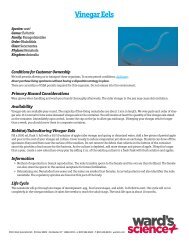WS_HSE_Catalog_VWR_new - Ward's Science
WS_HSE_Catalog_VWR_new - Ward's Science
WS_HSE_Catalog_VWR_new - Ward's Science
You also want an ePaper? Increase the reach of your titles
YUMPU automatically turns print PDFs into web optimized ePapers that Google loves.
iomedical technology | activities<br />
87<br />
Southern Blot<br />
Analysis Lab<br />
Activity<br />
Lead Students In a<br />
Hypothetical Paternity<br />
Determination<br />
Introduce students to the<br />
procedures of gel-transfer<br />
hybridization, also known as Southern Blotting. Students use this technique<br />
to detect specific DNA fragments in a simulated paternity determination.<br />
DNA fragments are separated by agarose gel electrophoresis, transferred<br />
to a membrane and then visualized by staining. This experiment is safe<br />
and easy to perform, and does not use human DNA. Includes materials for<br />
five blots. Requires agarose electrophoresis chamber, power supply, and<br />
10–20mL micropipets, available separately.<br />
368955 $115.99<br />
Ward’s Human<br />
Fingerprinting by<br />
PCR Lab Activity<br />
Investigate the Various<br />
Uses of DNA Polymorphism<br />
Identification in Individuals<br />
Certain DNA basepair sequences<br />
vary from person to person; for<br />
example, in one person a particular<br />
basepair sequence may be repeated<br />
ten times, while in another person<br />
the same sequence may be repeated<br />
25 times. Known as polymorphisms,<br />
the repetitions are an identifying<br />
factor in a person’s DNA, and thereby can be used for DNA fingerprinting in<br />
forensics, paternity testing, and disease diagnosis. The basepair sequences can<br />
be separated using electrophoresis and the resulting banding pattern used<br />
to distinguish one person from the next, which students perform with the lab<br />
activity. Using DNA isolated from their own cheek cells, students amplify a variable<br />
DNA region known as a D1S80 locus, electrophorese the DNA, and identify<br />
whether the student is homozygous or heterozygous for the D1S80 locus. The<br />
kit includes enough materials to run 24 PCR reactions, a teacher’s guide, and<br />
student copymaster. A thermal cycler or two water baths, electrophoresis<br />
chamber, power supply, variable volume micropipets, required, are available<br />
separately. Note: Coupon included for perishable materials. Redeem by mail,<br />
fax, phone, or e-mail.<br />
368858 With QUIKView Stain $159.69<br />
Ward’s Paternity<br />
Testing Lab Activity<br />
Determine Familial Relationships<br />
with DNA Fingerprinting<br />
Paternity was once determined by blood<br />
type, based on the concept that a child’s<br />
blood type depends on the blood type<br />
of the parents. Yet blood type can only<br />
exclude possible biological parents, not<br />
definitively determine the identity of the<br />
real parents. With DNA fingerprinting, however,<br />
it is possible to establish familial relationships<br />
with a high degree of certainty.<br />
In this lab activity, students work with a real-life situation,<br />
electrophoresing nonhuman DNA samples, simulating<br />
those of a child, mother, and two possible fathers; compare<br />
the banding patterns; and determine which of the<br />
two men is the most probable match to be the child’s<br />
biological father. The activity can be completed in two 60 minutes sessions and<br />
comes with enough materials to run eight gels, a teacher’s guide, and student<br />
copymaster. An electrophoresis chamber, power supply, and 10 mL micropipets,<br />
required, are available separately. Note: Coupon included for perishable materials.<br />
Redeem by mail, fax, phone, or e-mail.<br />
368551 With QUIKView Stain $101.99<br />
RT-PCR: A Module for the<br />
Molecular Biology of HIV<br />
Replication Lab Activity<br />
Modern Application of Advanced<br />
<strong>Science</strong><br />
Use this kit to demonstrate the mode of replication<br />
of HIV. The specific mRNA provided in this experiment<br />
is reverse transcribed to double-stranded<br />
DNA. This DNA product is then amplified by PCR.<br />
The resulting reactions contain reverse transcriptase<br />
and mimic the way HIV replicates. Includes six setups<br />
with instructions. A thermal cycler, horizontal<br />
gel tank, power supply, micropipets with tips, balance,<br />
and water bath, are required, but not included. Note: Coupon included for<br />
perishable materials. Redeem by mail, fax, phone, or e-mail.<br />
368956 $199.69<br />
Ward’s Determining DNA<br />
Concentration and Purity<br />
Lab Activity<br />
Analyze DNA Samples Using UV<br />
Spectrophotometry<br />
Techniques used to quantify DNA or to determine<br />
the purity of a DNA sample are important<br />
precursors to performing further analysis and<br />
validating results. In this activity, students will<br />
first learn to quantify unknown DNA samples<br />
by generating and interpreting a standard curve<br />
based on UV absorbance. They will then isolate DNA from their own cheek<br />
cells and determine the purity of the sample using a ratio of 260/280 nm wavelength.<br />
The kit includes enough materials for eight setups, a teacher’s guide, and<br />
student copymaster. A UV spectrophotometer, microcentrifuge, incubator, and<br />
waterbath, as well as quartz cuvettes and micropipets, all required, are available<br />
separately. Note: Coupon included for perishable materials. Redeem by mail,<br />
fax, phone, or e-mail.<br />
366270 $74.19<br />
Principles of DNA<br />
Sequencing Lab<br />
Activity<br />
Explains Methods Used<br />
For Understanding the<br />
Molecular Structure and<br />
Function of DNA<br />
A dry lab explaining DNA sequencing<br />
and analysis, this activity illustrates<br />
how DNA sequencing is used<br />
to determine the primary structure of DNA. Actual autoradiograms from DNA<br />
sequencing experiments are provided for identification of mutated nucleotides.<br />
Contents can also be viewed using an overhead projector for full class viewing.<br />
For your convenience and safety, this experiment does not contain radioactive<br />
materials, does not require electrophoresis, and does not contain any perishable<br />
reagents or supplies. Highly recommended: visible light box for individual or<br />
student group viewing of autoradiograms. An overhead projector may be used<br />
for entire class viewing. Includes materials for six setups.<br />
368958 $56.65<br />
ward’s<br />
science+





